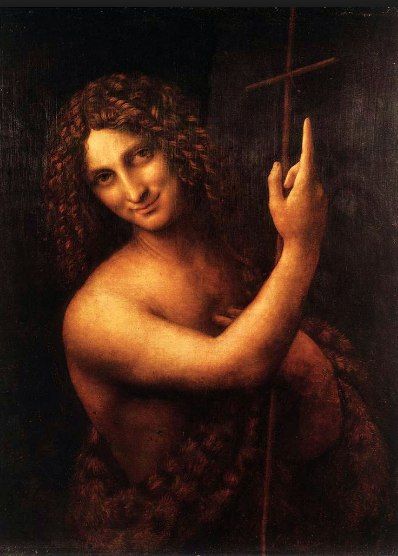
In this version, the Virgin Mary is seated with Jesus in a hilly landscape with a mountain range at the horizon. Jesus is looking at a yarnwinder, used to collect spun yarn. The symbolism behind this would indicate first a foreshadowing of Jesus's death at the Cross, and secondly Mary's domesticity.
Then Saint John The Baptist, oil on walnut, completed by Leonardo da Vinci somewhere between 1513 and 1516 and reportedly his last painting. It is exhibited at the Musée du Louvre in Paris. Even though it was his last work, it's a magnificent piece of art making use of the Chiaroscuro technique, developed during the Renaissance. Chiaroscuro aimed to create a threedimensional impression by making it seem as if the well-lit subject emerged from a pinch dark background:

The piece is curious in that Leonardo's Saint John has nothing of the dignity one would expect of Jesus' predecessor, as in other works by Renaissance artists, like Veronese and especially Titian. At first sight the figure is - I am weighing my words here - almost creepy. If you google it, you will come across versions where John is even far less lit, which enhances the unsettling character even more. Also, to us denizens of the twenty-first century there's the added disturbance of the particular gesture with the pointed finger the subject makes. Finally, the well-known German art historian and Professor Frank Zoellner, in his 2000 work Leonardo da Vinci, 1452-1519 writes that da Vinci's use of the sfumato technique "conveys the religious content of the picture," and that "the gentle shadows imbue the subject's skin tones with a very soft, delicate appearance, almost androgynous in its effect, which has led to this portrayal being interpreted as an expression of Leonardo's homoerotic leanings." (*)
Anyway, whatever the painting suggests, either some kind of a (more than) affectionate tribute to the graces of the supposed model (Salai, one of da Vinci's pupils), or a playful reminder of the great Renaissance painter that now is the time to go to Heaven (hopefully), you don't have to be an art historian to appreciate the immense beauty and value of Leonardo's Saint John.
Good night.
MFBB.
(*) [sfumato, from the Italian fumo, smoke; it's a way to make subjects more realistic by painting the subject's delineations vis-à-vis the surroundings with soft strokes instead of clear lines; MFBB]).